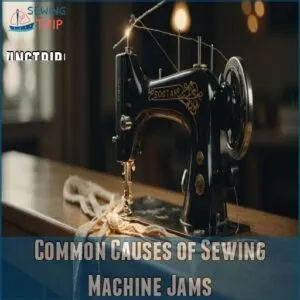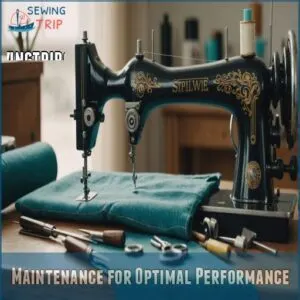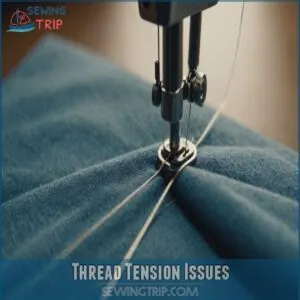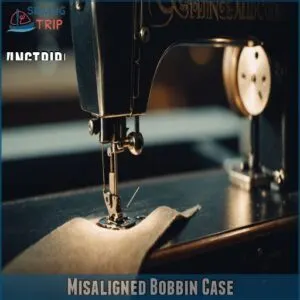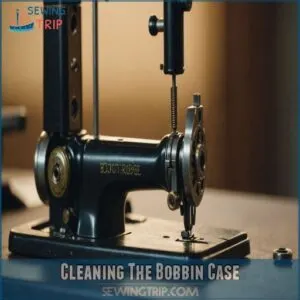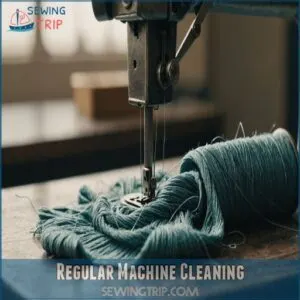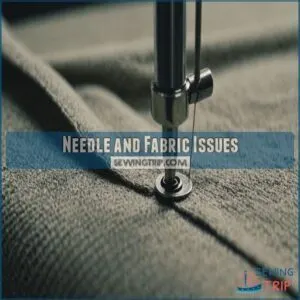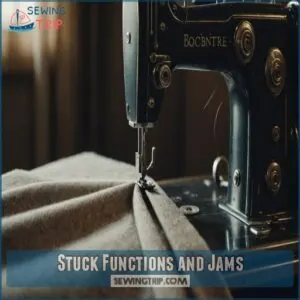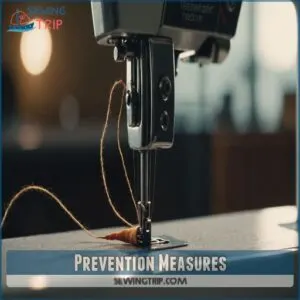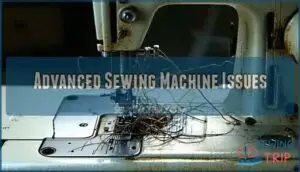This site is supported by our readers. We may earn a commission, at no cost to you, if you purchase through links.
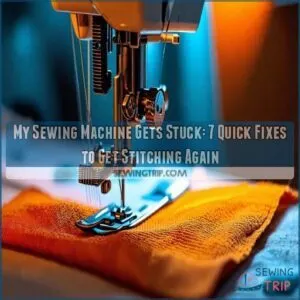 If your sewing machine gets stuck, it’s like having a stubborn mule in your craft room.
If your sewing machine gets stuck, it’s like having a stubborn mule in your craft room.
Start by checking the thread tension; if it’s off, your machine might just refuse to cooperate.
Next, make sure the needle isn’t bent or dull—sometimes they’re secretly moonlighting as bananas.
Keep an eye on lint build-up, too; even a tiny fluff party can jam things up.
Finally, make sure your bobbin is wound and placed correctly.
It’s amazing how a little maintenance can prevent meltdowns!
Curious about tackling those pesky reverse stitches or need more insights? The next part dives into all that and more.
Table Of Contents
- Key Takeaways
- Common Causes of Sewing Machine Jams
- Maintenance for Optimal Performance
- Thread Tension Issues
- Bobbin Case Problems
- Needle and Fabric Issues
- Stuck Functions and Jams
- Troubleshooting Sewing Machine Jams
- Prevention Measures
- Advanced Sewing Machine Issues
- Professional Servicing and Repair
- Frequently Asked Questions (FAQs)
- Conclusion
Key Takeaways
- Check your sewing machine’s thread tension, as mastering thread tension is the secret sauce for picture-perfect stitches. Check your sewing machine’s thread tension, needle condition, and bobbin placement to prevent jams and ensure smooth operation.
- Clean lint and debris regularly from the bobbin area and other parts of the machine to avoid fabric and thread tangling issues.
- Use the correct needle and thread combination for your fabric type to prevent snagging and fabric damage.
- Perform regular maintenance, like oiling and inspecting parts, and seek professional help if DIY fixes don’t resolve stubborn issues.
Common Causes of Sewing Machine Jams
When your sewing machine gets stuck, it’s usually due to a few common culprits.
From tangled threads to lint buildup, understanding these issues can help you get back to stitching in no time.
Improper Threading
Ever felt like you’re threading a needle in the dark?
Improper threading, often caused by issues like thread tension problems, is a common culprit behind sewing machine jams.
Here’s your thread-taming game plan:
- Double-check your thread path from spool to needle
- Make sure the presser foot’s up while threading
- Thread with gentle tension, avoiding knots
- Re-thread completely if you spot any issues
Remember, a well-threaded machine is your ticket to smooth stitching.
Don’t let tangled threads unravel your sewing mojo!
Bent or Dull Needle
Is your sewing machine acting up? A bent or dull needle might be the culprit. It’s like trying to cut with a butter knife – frustrating and ineffective. Check your needle regularly for signs of wear or damage. Here’s a quick guide to help you spot and fix needle issues:
| Problem | Symptom | Solution |
|---|---|---|
| Bent needle | Skipped stitches | Replace immediately |
| Dull needle | Thread snags | Change every 6-8 hours |
| Wrong size | Fabric damage | Match to fabric weight |
| Noisy sewing | Excessive clicking | Inspect and replace |
Accumulated Lint or Fabric Fibers
Over time, your sewing machine becomes a lint magnet.
Tiny fabric fibers sneak into every nook and cranny, causing jams faster than you can say "stitch."
Regularly inspecting and replacing worn-out sewing machine parts, such as those found at sewing machine parts, can also help prevent issues.
To keep your machine purring, grab your lint brush and get friendly with the bobbin case.
Regular cleaning is your secret weapon against pesky jams.
Think of it as giving your trusty machine a spa day – it’ll thank you with smooth stitches every time.
Incorrectly Placed or Wound Bobbins
Your sewing machine’s bobbin can be a real troublemaker.
After cleaning out lint, don’t forget to check if your bobbin’s playing nice.
Incorrectly placed or wound bobbins are like hidden gremlins, causing all sorts of mischief.
For example, a common issue is when the bobbin thread isn’t coming up, usually due to incorrect threading, so refer to sewing machine bobbin problems solutions for guidance.
Here’s a quick bobbin boot camp to keep you stitching smoothly:
- Wind bobbins evenly, avoiding gaps or bulges
- Insert the bobbin in the correct direction (check your manual!)
- Make sure the bobbin case is clean and properly seated
- Double-check bobbin tension – it should pull smoothly but with slight resistance
Thick or Unusual Fabrics
While bobbins can be tricky, thick fabrics are a whole different beast.
They’re like trying to sew a rug to your jeans!
Heavy denim or leather can overwhelm your machine, causing jams.
Try adjusting your tension and using a heavier needle.
Don’t forget to switch to a walking foot – it’s like giving your fabric a piggyback ride through the machine.
With these tweaks, you’ll be stitching through tough stuff in no time!
Maintenance for Optimal Performance
Now that we’ve covered common jam causes, let’s talk about keeping your sewing machine humming along.
Think of it as a spa day for your trusty stitching companion!
Start with a cleaning schedule – once a month should do the trick.
Grab a lint brush and give those feed dogs a good brushing.
Don’t forget to oil up those moving parts; a well-oiled machine is a happy machine.
Refer to a detailed sewing machine maintenance checklist to make sure you’re covering all your bases.
But easy does it – a little sewing machine oil goes a long way.
Keep an eye out for worn-out parts, like belts or needles, and replace them before they cause trouble.
It’s like changing your car’s oil – a bit of preventative care saves you headaches down the road.
And hey, if you’re feeling overwhelmed, there’s no shame in calling in the pros for a tune-up.
Your sewing machine will thank you with smooth stitches and fewer hiccups!
Thread Tension Issues
Thread tension issues can turn your sewing project into a tangled mess faster than you can say "bobbin."
You’ll know you’re in trouble when your stitches look like a rollercoaster ride or your fabric puckers like it’s trying to make a fashion statement.
Loose Thread Tension
Thread tension driving you nuts? Loose tension can turn your stitches into a sloppy mess. It happens when your machine can’t pull the thread tight enough through the fabric.
To fix this, start by checking your threading. Make sure the thread’s seated properly in the tension discs.
If that doesn’t do the trick, try adjusting the tension dial. Remember, different fabrics need different tensions, so don’t be afraid to experiment!
Tight Thread Tension
On the flip side, tight thread tension can be just as tricky.
You’ll know it’s too tight when your fabric puckers or your thread snaps like a guitar string.
It’s like trying to squeeze through a packed subway car – things get tense!
Let’s unravel this knot together.
- Thread breaks faster than New Year’s resolutions
- Fabric puckers like it’s doing the cha-cha
- Stitches look like they’re holding their breath
- Your sewing machine sounds grumpier than usual
Adjusting Thread Tension
Taming the tension dial can feel like wrangling a wild beast, but you’ve got this!
Start by testing different settings on scrap fabric.
Turn the dial up for thicker materials and down for delicate ones.
Here’s a quick guide to help you become a tension tamer:
| Fabric Type | Upper Tension | Lower Tension |
|---|---|---|
| Lightweight | 2-3 | Looser |
| Medium | 4-5 | Medium |
| Heavy | 6-7 | Tighter |
Remember, it’s all about balance.
You’ll be stitching like a pro in no time!
Using High-Quality Thread
For smooth sewing, quality thread is your secret weapon.
You’ll face fewer snags and breaks with excellent thread, saving time and frustration.
Compare brands to find the sweet spot between cost and quality.
Remember, cheap thread can shed lint, clogging your machine.
Invest in good thread that matches your project and machine specs.
It’s a small change that’ll keep your stitches strong and your sewing stress-free.
Bobbin Case Problems
Your sewing machine’s bobbin case can be a sneaky troublemaker, causing jams and frustration.
If it’s misaligned or dirty, you’ll find yourself in a tangled mess, but don’t worry – we’ll show you how to get things running smoothly again.
Misaligned Bobbin Case
Now, let’s talk about your bobbin case. It’s like the heart of your sewing machine, and when it’s out of whack, things can get messy.
A misaligned bobbin case can cause all sorts of headaches, from skipped stitches to thread nests.
Check if it’s sitting snug in its spot. If it’s wobbling or feels loose, you might need to adjust or replace it.
Don’t worry, it’s not rocket science!
Dirty Bobbin Case
Got your bobbin case all lined up, but something’s still off?
A dirty one could be the culprit.
Signs of a dirty bobbin case might remind you of your messy room—thread bunches up, tension feels awry.
Regular bobbin case maintenance is your best friend here, and spotting these issues can save you from pulling your hair out.
Cleaning The Bobbin Case
To tackle bobbin case issues, the key lies in regular cleaning.
Use the right bobbin case cleaning tools and follow these steps:
- Remove the bobbin case.
- Brush away lint and debris.
- Wipe gently using a soft cloth.
- Reassemble carefully to prevent alignment errors.
Avoid common bobbin case cleaning mistakes for smooth stitching and effective bobbin case maintenance.
Regular Machine Cleaning
Imagine this: you’re ready to sew, but your machine’s stuck, pointing blame at a dirty bobbin case.
A regular cleaning schedule is your best ally—you’ll need some basic cleaning supplies and tool essentials.
Think of yourself as a machine whisperer!
Remember, regular lint removal is key to keeping your sewing adventures smooth and worry-free.
Needle and Fabric Issues
When your sewing machine gets stuck, the culprit might be a mismatched needle or incompatible fabric.
Choosing the right needle and fabric can save you from tangled messes and broken needles, so keep those sewing projects running smoothly!
Choosing The Right Needle
Think of your sewing needle as a trusty sidekick.
Picking the right one is key to avoiding fabric snags.
Matching the right needle size to your fabric type is essential, as some fabrics require specific types of needles, such as universal needles for different fabrics.
Match needle size to thread and fabric types.
Opt for quality needle brands—your stitches will thank you.
With thread compatibility, harmony’s essential.
Always check if your needle’s sharp and suited for the task to keep things smooth.
Fabric Compatibility
You’ve got the needle sorted, so let’s chat fabric.
Matching fabric weight with needle size is like pairing shoes with an outfit—get it wrong, and nothing fits right!
Check your machine’s capabilities against fabric types.
Use a lightweight needle for delicate fabrics and adjust stitch length to avoid jams.
It’s your machine’s way of saying, "Let’s sew smoothly!
Using Heavier Needles and Thread
Before tackling thick fabrics, upgrade your needle size and thread weight.
A heavier needle prevents bending, while thicker thread matches the fabric’s density.
Consider your machine’s capabilities; some machines aren’t built for heavy-duty projects.
Choosing the right needle size and thread weight prevents jams and guarantees a smooth sewing experience.
Remember to always check your machine’s manual for recommendations!
Stuck Functions and Jams
If your sewing machine acts like it’s holding a strike and refuses to budge, don’t panic—stuck functions and jams are common hiccups that can be fixed.
Whether it’s stuck in reverse or tangled up in the bobbin, understanding what’s going wrong helps you get back to stitching in no time.
Sewing Machine Stuck in Reverse
Is your sewing machine stuck in reverse, making it hard to move forward with your project?
First, check if the reverse lever is jammed or the reverse function settings are off.
Sometimes, feed dogs get stubbornly stuck, causing reverse stitch problems.
If you’re still puzzled, consult the machine’s manual or consider professional help for reverse troubleshooting tips.
Sewing Machine Stuck in Bobbin Mode
If your machine’s stuck in bobbin mode, it’s like trying to drive in reverse while stuck in neutral—frustrating, right?
Check if the bobbin winder issues are physical, like a stuck lever, or if computerized machine errors are at play.
Adjust bobbin tension problems and try a reset.
For stubborn cases, preventing bobbin jams might require professional help.
Needle Stuck in Fabric
You’ve tackled the bobbin mode hiccup, so let’s chat about when the needle stubbornly sticks in fabric.
Check that needle size matches the fabric type and thread quality.
Make sure your Needle plate is clear and slow down your sewing speed.
Here are some handy tips:
- Match needle size to fabric
- Use quality thread
- Clean needle plate
- Adjust sewing speed
- Inspect for thread tangles
Fabric Getting Stuck in The Machine
Struggling with fabric getting stuck? We’ve all been there.
Check your fabric weight and adjust the stitch length—it’s like swapping icy roads for snow tires.
Make sure feed dogs are clear and clean the needle plate, too.
Test on scrap fabric to avoid mishaps.
The right needle size makes a world of difference, ensuring smooth sailing with any fabric type.
Troubleshooting Sewing Machine Jams
Machine jams are about as welcomed as a rainy parade, but don’t lose your stitch!
Troubleshooting common sewing machine jams often starts with checking for needle problems, which can be caused by dull or bent needles that catch and break the material, and then a close look at your threading.
Make sure there are no sneaky tangles or missteps there.
Regular checks of your sewing machine thread for any signs of wear or damage can also go a long way.
Ever wondered if the bobbin’s playing pranks?
Check its tension and placement to see if they need a tweak.
Your needle might be the unsung hero—or culprit.
Identifying thread tension issues can shed light on this too.
Choose the right needle size for your fabric type, keeping in mind those compatibility issues.
These steps can clear that jam-up, setting you back on a smooth sewing path.
Getting to know your machine’s quirks might just make it your new best friend!
Prevention Measures
Let’s face it, a jammed sewing machine is nobody’s idea of fun.
Preventing those frustrating moments involves regular cleaning, using the right needle and thread for your fabric, and avoiding overloading your machine—think of it as preventative maintenance for your trusty stitching sidekick!
Regular Cleaning and Maintenance
Keeping your sewing machine purring like a kitten involves some regular TLC.
Grab those sewing machine cleaning tools and stick to a maintenance schedule, making preventative maintenance your best friend.
Clean the bobbin area frequently and don’t forget a drop of oil here and there.
With these oiling tips, your machine won’t let you down when you’re crafting masterpieces!
Proper Threading and Tension
Mastering thread tension can save headaches in sewing!
Start by checking the basics: correct threading path and tension dial settings.
Here are five quick tips:
- Double-check your threading.
- Adjust the tension dial thoughtfully.
- Use quality thread for less fuss.
- Test bobbin tension regularly.
- Troubleshoot tension issues immediately.
Nail these steps, and you’ll tame the sewing beast!
Using The Right Needle and Fabric
Selecting the correct needle and fabric is like choosing shoes for a hike—you need the right type to avoid trouble.
Use the needle size chart and fabric weight guide to match your materials.
This makes sure thread type compatibility and stitch length optimization.
Plus, a proper needle gauge selection keeps your sewing tension-free and your projects looking great!
Avoiding Overloading The Machine
Think of your sewing machine as someone who prefers lite lifting over heavy loads.
Keep an eye on fabric weight and be mindful of layer limits—it’s like overloading a backpack that can’t take more.
Plan projects with suitable fabrics that match your machine’s capacity.
Smart project planning keeps your machine humming happily, avoiding unnecessary strain.
Advanced Sewing Machine Issues
When your sewing machine seems to have a mind of its own, like a foot pedal that sticks or a motor that plays hide and seek, it can be downright frustrating.
Let’s unravel these advanced issues together, so you can get back to creating your next masterpiece without a hitch.
Stuck Foot Pedal
When your sewing machine’s foot pedal feels stuck, it can be frustrating, like stepping on a stuck gas pedal.
First, check for debris blocking its movement.
Consider upgrading with a new Sewing Machine Foot for improved performance.
Gently clean it to make sure it operates smoothly.
If it still hesitates, you may need to troubleshoot further or consider pedal replacement or repair.
Consistent pedal cleaning and adjustment can keep your sewing smooth.
Motor Issues
Okay, so your foot pedal’s fine, but now your motor’s acting up?
Listen for unusual Motor noise; overheating is a common culprit.
Is your Speed control erratic?
Power surges can fry a motor.
If it’s beyond repair, Motor replacement might be your best bet.
Don’t panic—many sewing machine repair shops can help!
Stuck Handwheel
Ever had a sewing marathon interrupted by a stuck handwheel?
Don’t fret. It’s often due to fabric jams or tangled threads.
First, turn off the machine and gently check for anything stuck around the needle.
Look for any needle jams or motor issues too.
No need to panic; a little patience usually gets things moving again.
Stuck Presser Foot
Wrestling with a stuck presser foot can feel like trying to run a marathon in flip-flops.
Is your presser foot stuck down or refusing to go up?
First, check for any debris and clean the area.
It may also be helpful to adjust the presser foot height for the best stitch quality using a presser foot gauge.
A broken presser foot lever might need a gentle nudge or replacement.
Adjust any presser foot tension issues, and you’ll be back on track in no time!
Professional Servicing and Repair
Contemplating professional servicing might feel like admitting defeat, but sometimes it’s the smartest move.
Sometimes, a stuck sewing machine can be caused by a malfunctioning feed dog, which may require checking the feed dog lever. Your sewing machine’s intricate gears and parts can require more than home remedies.
Checking in with certified technicians at local repair shops guarantees expert care and might save you cash in the long run.
You can find a reputable repair shop near you by searching online for a sewing machine repair shop.
Warranty coverage often offsets repair costs, making it an economical choice.
Have you ever wondered about service intervals?
Genuine care involves routine check-ups, just like with cars.
Skipping these can lead to bigger issues later.
Don’t stitch past the point of no return—if your machine’s acting up and DIY fixes falter, trust the pros.
Remember, just like you wouldn’t perform surgery on yourself, some tasks are best left to experts.
Frequently Asked Questions (FAQs)
Why is my fabric stuck in my sewing machine?
Think of your sewing machine as a city street jammed with traffic.
Fabric might be stuck due to dirt near the needle plate or the wrong stitch length.
Try cleaning and adjusting settings to clear the roadblocks.
Why does my sewing machine get stuck in the bobbin area?
Bobbin area jams? Check for tangled thread, lint buildup, or a poorly wound bobbin.
A bent needle‘s a common culprit too! Clean it out, and you’ll be sewing smoothly in no time.
Why is my sewing machine stuck in reverse?
When your sewing machine feels like it’s moonwalking, check for stuck feed dogs or a malfunctioning reverse lever.
Sometimes computers glitch too, so check settings, and if it still misbehaves, maybe it’s time for a professional’s touch.
Why is my sewing machine not working properly?
Check your sewing machine for common issues: tangled thread, incorrect tension, dull needles, and lint buildup.
Regular maintenance keeps it humming smoothly, like a well-oiled machine.
Make sure you have the correct threading and a suitable needle for your fabric.
Why does my sewing machine keep getting stuck?
Stubborn stitching stalls your sewing spree due to tangled threads, bent needles, or tension trouble.
Regularly clean the machine, check needle size, and adjust tension.
When all else fails, professional servicing can sort sneaky, stubborn snags.
How to stop sewing machine jamming?
Start by checking your needle—make sure it’s straight and sharp.
Clean lint from the bobbin area regularly, and adjust thread tension properly.
Use the right thread and fabric combo.
Keep your machine well-oiled and serviced.
Why is my sewing machine not moving?
Your sewing machine might be frozen due to tangled thread or a bent needle.
Check for lint build-up in the bobbin area, improper threading, or settings.
Regular cleaning and maintenance can prevent these issues from driving you "sew" crazy!
Why does my sewing machine keep getting tangles?
Tangled threads can turn a sewing session into a headache.
Check for improper threading, high tension, or wrong needle size.
Clean the bobbin area regularly, ensuring everything’s aligned.
Adjust settings to match fabric and thread.
Why does my machine make strange noises?
Weird sewing machine noises? It could be a loose part, a buildup of lint, or even a worn-out belt.
Check everything; a little TLC might fix it!
If not, call a pro.
Can foot pedals affect machine speed?
Foot pedals are your sewing machine’s gas pedal, controlling speed based on pressure.
Push gently for slow stitches, or step harder to sew faster.
If speed feels off, check for debris or mechanical issues under the pedal.
Are there quick fixes for motor issues?
Imagine your motor as a rhythm section getting offbeat.
You can check power cables for loose connections, make sure the pedal’s free of debris, and listen for strange noises signaling a bigger problem needing professional help.
Do sewing tables impact machine stability?
A sturdy sewing table can improve machine stability, reducing vibrations and helping your projects run smoothly.
It’s like giving your machine a solid dance floor—no more wobbly stitches or frustrating movements.
Invest in a quality one!
How to handle fabric snagging on presser foot?
Think of it like fixing a stuck zipper.
Adjust your stitch length and check the needle size.
Make sure the needle’s sharp and suitable for the fabric to prevent snags.
Clean the presser foot regularly for smooth sewing.
Conclusion
Dealing with a sewing machine that gets stuck can feel like solving a puzzle, but armed with these tips, you’re ready to conquer jams.
Regular maintenance, like checking thread tension and cleaning the bobbin case, prevents these pesky issues.
Make sure your needle matches your fabric and avoid overloading your machine.
When snags occur, tackle them swiftly with troubleshooting techniques.
If all else fails, professional help is available.
Keep your machine humming smoothly and enjoy stress-free sewing!

